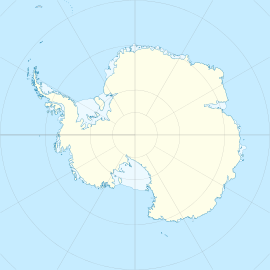
Back Ice Runway CEB Aeródromo Ice Runway Spanish آیس رانوی Persian Ice Runway French Ice Runway repülőtér Hungarian Lapangan Terbang McMurdo Station Malay Ice Runway Dutch Ice Runway Swedish Айс Ранвей Tajik
Ice Runway | |||||||||||||||
|---|---|---|---|---|---|---|---|---|---|---|---|---|---|---|---|
 C-5 Galaxy unloading at sea ice runway, near McMurdo Station, 1999. | |||||||||||||||
| Summary | |||||||||||||||
| Location | McMurdo Sound, Antarctica | ||||||||||||||
| Elevation AMSL | 1 ft / 0 m | ||||||||||||||
| Coordinates | 77°51′14″S 166°28′07″E / 77.85389°S 166.46861°E | ||||||||||||||
| Map | |||||||||||||||
 | |||||||||||||||
| Runways | |||||||||||||||
| |||||||||||||||
The Annual Sea-Ice Runway (ICAO: NZIR) [3] is a type of seasonal ice runway made on frozen McMurdo Sound for the U.S. Antarctic Program during the summer Antarctic field season in proximity to Hut Point Peninsula, which has McMurdo Station and Scott Base. The ice runway was used since the 1950s when the bases were established, but has fallen out favor in 2010s in favor of two runways on land, at Williams Field (NZWD) and the compacted snow runway at Phoenix Airfield (NZFX), which replaced Pegasus Field (NZPG) in 2017. The ice runway was prepared on frozen sea ice on open water in McMurdo Sound, so its exact location varied slightly year to year. The ice was strong enough to land large transport aircraft with traditional landing gear, and no aircraft broke through the ice in its operation; however, parked aircraft had to be monitored if they lowered the ice too much and this is due to the special properties of floating ice.
The sea ice runway was capable of handling wheeled aircraft, which have included to date: Lockheed C-5 Galaxy, Lockheed C-141 Starlifter, Boeing C-17 Globemaster III, Lockheed C-130 Hercules and Lockheed P-3 Orion. In the summer season of 2009/2010 the RNZAF trialed a modified Boeing 757 operationally. The intention was to use the Boeing 757 for passenger transport, thereby freeing up capacity for C-17 cargo space.[4]
The runway was usually operated from October to December, after which time the sea ice would break up. The ice for the runway would be over 2 meters/yards thick to land an aircraft like the C-17.[5] (In context, this time period corresponds to the Antarctic dawn there, when McMurdo switches from 24 hour darkness to light)
The annual sea-ice runway for wheeled aircraft was constructed at the start of each season and used until early December when the sea ice began to break up.[6] Subsequently, flight operations were moved back to Williams Field. Pilots landing C-17 Globemaster III cargo aircraft on the sea ice runway reported that the surface was stable, not unlike landing on concrete. The similarity with land bases ended when the jet aircraft rolled to a stop, however. The nearly 450,000 pound (= 201 tons) weight of the plane, including cargo and passengers, caused it to sink into the ice, albeit only a matter of inches. A laser light was trained on the aircraft to measure the settlement rate. The $200 million aircraft was moved to a new location on the six-foot-thick ice as a safety measure if the 10-inch red line was reached, according to the News Tribune in Tacoma, Washington.[citation needed]
- ^ "Airport information for NZIR". World Aero Data. Archived from the original on 2019-03-05. Data current as of October 2006. Source: DAFIF.
- ^ Airport information for NZIR at Great Circle Mapper. Source: DAFIF (effective October 2006).
- ^ "Aircraft Landing Areas". Archived from the original on 2017-05-28.
- ^ "Royal New Zealand Air Force".
- ^ "Notes from the Field - We are in Antarctica!". earthobservatory.nasa.gov. 2011-12-01. Retrieved 2024-12-31.
- ^ Blue-ice and snow runways, National Science Foundation Office of Polar Programs. April 9, 1993.
